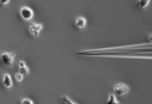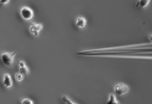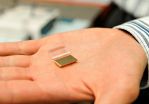(Press-News.org) VIDEO:
In this video, lab-grown human leukemia cells move toward a pipette tip holding an attractive chemical.
Click here for more information.
Amoebas aren't the only cells that crawl: Movement is crucial to development, wound healing and immune response in animals, not to mention cancer metastasis. In two new studies from Johns Hopkins, researchers answer long-standing questions about how complex cells sense the chemical trails that show them where to go — and the role of cells' internal "skeleton" in responding to those cues.
In following these chemical trails, cells steer based on minute differences in concentrations of chemicals between one end of the cell and the other. "Cells can detect differences in concentration as low as 2 percent," says Peter Devreotes, Ph.D., director of the Department of Cell Biology at the Johns Hopkins University School of Medicine. "They're also versatile, detecting small differences whether the background concentration is very high, very low or somewhere in between."
Working with Pablo Iglesias, Ph.D., a professor of electrical and computer engineering at Johns Hopkins, Devreotes' research group members Chuan-Hsiang Huang, Ph.D., a research associate, and postdoctoral fellow Ming Tang, Ph.D., devised a system for watching the response of a cellular control center that directs movement. They then subjected amoebas and human white blood cells to various gradients and analyzed what happened. "Detecting gradients turns out to be a two-step process," says Huang. "First, the cell tunes out the background noise, and the side of the cell that is getting less of the chemical signal just stops responding to it. Then, the control center inside the cell ramps up its response to the message it's getting from the other side of the cell and starts the cell moving toward that signal." The results appear on the Nature Communications website on Oct. 27.
But to get going, the cell has to have first arranged its innards so that it's not just a uniform blob but has a distinct front and back, according to another study from Devreotes' group. In that work, visiting scientist Mingjie Wang, Ph.D., and postdoctoral fellow Yulia Artemenko, Ph.D., tested the role of so-called polarity — differences in sensitivity to chemicals between the front and back of a cell — in responding to a gradient. "In previous studies, researchers added a drug that totally dismantled the cells' skeleton and therefore eliminated movement. They found that these cells had also lost polarity," Artemenko says. "We wanted to know whether polarity depended on movement and how polarity itself — independent of the ability to move — helped to detect gradients."
The team used a pharmaceutical cocktail that, rather than dismantling the cells' skeleton, froze it in place. Then, as in Huang's experiments, they watched the response of the cellular control center to chemical gradients. "Even though the cells couldn't remodel their skeleton in order to move, they did pick up signals from the gradients, and the response to the gradient was influenced by the frozen skeleton," Artemenko says. "This doesn't happen if the skeleton is completely gone, so now we know that the skeleton itself, not its ability to remodel, influences the detection of gradients." The results appear in the Nov. 6 issue of Cell Reports.
By fleshing out the details of how cells move, the results may ultimately shed light on the many crucial processes that depend on such movement, including development, immune response, wound healing and organ regeneration, and may provide ways to battle cancer metastasis.
INFORMATION:
Other authors on the Cell Reports paper are Wenjie Cai and Pablo Iglesias of The Johns Hopkins University. The study was funded by the National Institute of General Medical Sciences (grant numbers GM28007 and GM34933) and the National Natural Science Foundation of China (grant numbers 81000045 and 81000939).
Other authors on the Nature Communications paper are Mingjie Wang and Changji Shi of The Johns Hopkins University. The work was supported by the National Institute of General Medical Sciences (grant numbers GM28007, GM34933 and GM71920) and a Harold L. Plotnick Fellowship from the Damon Runyon Cancer Research Foundation.
Related stories:
Peter Devreotes on cell movement: http://www.hopkinsmedicine.org/institute_basic_biomedical_sciences/about_us/scientists/peter_devreotes.html
'Random' Cell Movement Is Directed from Within: http://www.hopkinsmedicine.org/news/media/releases/randon_cell_movement_is_directed_from_within
Berlin, 27 October 2014. Not everyone who contracts the Ebola virus dies, the survival rate is around 30% suggesting that some kind of immunity to the disease is possible. Experimental treatments and vaccines against Ebola exist but have not yet been tested in large groups for safety and efficacy (phase 2 trials).
The International Union of Immunology Societies (IUIS) published a statement today in its official journal, Frontiers in Immunology calling for urgent and adequate funding of vaccine candidates in clinical trials and speedy implementation of immunisation in ...
A new study has found that patients who received chest radiation for Wilms tumor, a rare childhood cancer, face an increased risk of developing breast cancer later in life due to their radiation exposure. Published early online in CANCER, a peer-reviewed journal of the American Cancer Society, the findings suggest that cancer screening guidelines might be re-evaluated to facilitate the early diagnosis and prompt treatment of breast cancer among Wilms tumor survivors.
Wilms tumor is a rare childhood kidney cancer that can spread to the lungs. When this spread occurs, patients ...
Today, the International Osteoporosis Foundation (IOF) has published an educational slide deck highlighting 60 original scientific abstracts presented at the Annual Meeting of the American Society for Bone and Mineral Research (ASBMR) in September 2014.
The succinct slide kit can be downloaded free of charge by all individual IOF members (free sign up on the IOF website).
CEO Judy Stenmark stated, "IOF is pleased to provide this informative resource for healthcare professionals interested in the latest advances in bone and mineral research. While 10% of the featured ...
Toronto, Canada – Making mistakes while learning can benefit memory and lead to the correct answer, but only if the guesses are close-but-no-cigar, according to new research findings from Baycrest Health Sciences.
"Making random guesses does not appear to benefit later memory for the right answer , but near-miss guesses act as stepping stones for retrieval of the correct information – and this benefit is seen in younger and older adults," says lead investigator Andrée-Ann Cyr, a graduate student with Baycrest's Rotman Research Institute and the Department ...
VANCOUVER ─ Different ethnic groups have widely varying differences in both the prevalence and awareness of cardiovascular risk factors, a finding that highlights the need for specially designed education and intervention programs, according to a study presented today at the 2014 Canadian Cardiovascular Congress.
The conclusion comes from a study of more than 3,000 patients at an urgent-care clinic serving an ethnically diverse area of Toronto. Participants were asked to self-identify their ethnicity and, from a list of 20 activities or conditions, asked to identify ...
VANCOUVER ─ People facing mental health challenges are significantly more likely to have heart disease or stroke, according to a study presented today at the Canadian Cardiovascular Congress.
"This population is at high risk, and it's even greater for people with multiple mental health issues," says Dr. Katie Goldie, lead author of the study and a postdoctoral fellow at the Centre for Addiction and Mental Health in Toronto
Using data from the Canadian Community Health Survey, Dr. Goldie explored the associations between cardiovascular risk and disease, mental ...
VANCOUVER ─ Heart surgery patients who received newly donated blood have significantly fewer post-operative complications than those who received blood that had been donated more than two weeks before their surgery, a study presented at the Canadian Cardiovascular Congress has shown.
The study examined records at the New Brunswick Heart Centre (NBHC) in Saint John for non-emergency heart surgeries performed over almost nine years, from January 2005 to September 2013, on patients who received red blood cells either during their surgery or afterwards and who stayed ...
This news release is available in French.
In less than a minute, a miniature device developed at the University of Montreal can measure a patient's blood for methotrexate, a commonly used but potentially toxic cancer drug. Just as accurate and ten times less expensive than equipment currently used in hospitals, this nanoscale device has an optical system that can rapidly gauge the optimal dose of methotrexate a patient needs, while minimizing the drug's adverse effects. The research was led by Jean-François Masson and Joelle Pelletier of the university's Department ...
In an analysis that included approximately 35,000 participants, genetic predisposition to elevated low-density lipoprotein cholesterol (LDL-C) was associated with aortic valve calcium and narrowing of the aortic valve, findings that support a causal association between LDL-C and aortic valve disease, according to a study appearing in JAMA. The study is being released to coincide with its presentation at the Canadian Cardiovascular Congress.
Aortic valve disease remains the most common form of heart valve disease in Europe and North America and is the most common indication ...
Stanford, CA— Proteins are the machinery that accomplishes almost every task in every cell in every living organism. The instructions for how to build each protein are written into a cell's DNA. But once the proteins are constructed, they must be shipped off to the proper place to perform their jobs. New work from a team of scientists led by Carnegie's Munevver Aksoy and Arthur Grossman, describes a potentially new pathway for targeting newly manufactured proteins to the correct location. Their work is published by The Plant Cell.
The team's discovery concerns ...


